|

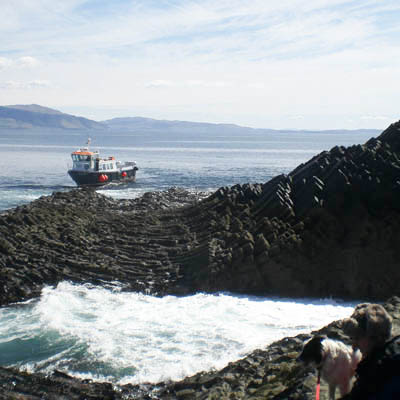 Isle of Staffa - Fingals Cave
Isle of Staffa - Fingals Cave
National Nature Reserve
Hebrides
Scotland
Telephone: 0844 493 2100 / 0844 493 2215
Fingal's Cave is the legendary home of a Gaelic Giant who quarrelled with his Ulster counterpart. The latter created a causeway between Ireland and Scotland but this was destroyed and all that remained were the two ends, one on Staffa and the other The Giants Causeway in Antrim. Today visitors do not need the mythological causeway, travelling from Oban you catch the ferry to the Isle of Mull. Travel across Mull to Fionnphort where a small fishing type boat/ferry takes you to Staffa. Here you alight near Clamshell Cave and the boat awaits your return after exploring. The journey takes a total of about 3 hours each way from Oban on the Scottish mainland. You can make a detour to Iona on the way adding to your journey. However do not attempt the crossings in bad weather and extreme care is required when finding your way across the cliffs to the cave entrance.
Pictures above right:
1. The Fishing type Boat from Mull awaits its passengers.
2. Approaching the Giants or Fingals Cave from the sea.
3. The pathway across the cliffs taken to explore Fingals Cave by the braver visitors while the waves crash down the channel cut in the rocks even on a calm day.
This legendary site has such a creative importance in the tourist psyche that, although natural and not man made, it justifies being classified as one of Great Britain's most stunning grottoes. The cave's Gaelic name, An Uaimh Bhinn, means "the melodious cave" and this reflects the awesome acoustics associated with this natural cathedral.
Whilst the mythology explains the cave to some, the geologists have a different explanation as to the cave's origins.
The amazing columns are basalt formed from volcanic lava some 60 million years ago. The sea subsequently eroded the basalt to create an island. Only small scraps of the basalt lava plateau now survive. The six sided columns vary in shape and alignment due to the different rates of cooling. Waves subsequently eroded cliff caves, exploiting the weaknesses inherent in the solidified lava. The name Staffa is thought to derive from the word staves which resemble the columns albeit staves were made from wood. Another naming hypothesis is that the Danes arrived in the ninth century in Ireland naming Dublin "Fingal" or "Land of the White Stranger". This Danish origin naming was perhaps also applied to the cave on Staffa.
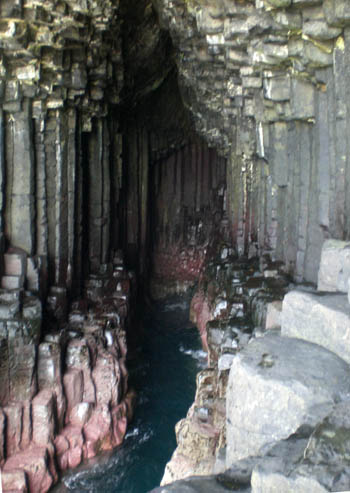
The view into the cave which is some 240 feet deep and 60 feet high; the waves continue their relentless erosion of the cavity.
Adjacent islands have been inhabited for at least 8000 years and Staffa has archaeology reflecting this. Ridge and furrow agriculture appears to have existed on the island at some point and it may be that Staffa was an overflow for Mull farmers during the growing season. There was also sheep grazing by crofters from Iona.
Tourism has been prevalent for centuries and a 19th century rock shelter exists at the top of the cliffs. Many famous people have visited the island including Queen Victoria and famous musicians have been inspired by the dramatic landscape. These include Felix Mendelssohn who composed The Hebrides "Die Hebriden" (Fingal's Cave) - Overture. Wildlife is in profusion, especially birds and sea life. The island was privately owned until 1986 when it was gifted to the National Trust for Scotland.

Staffa and Fingals Cave from the seaward.
Sir Walter Scott (1771-1832) described Fingals Cave after his visit:
..one of the most extraordinary places I ever beheld. It exceeded, in my mind, every description I had heard of it ...composed entirely of basaltic pillars as high as the roof of a cathedral, and running deep into the rock, eternally swept by a deep and swelling sea, and paved, as it were, with ruddy marble, baffles all description.
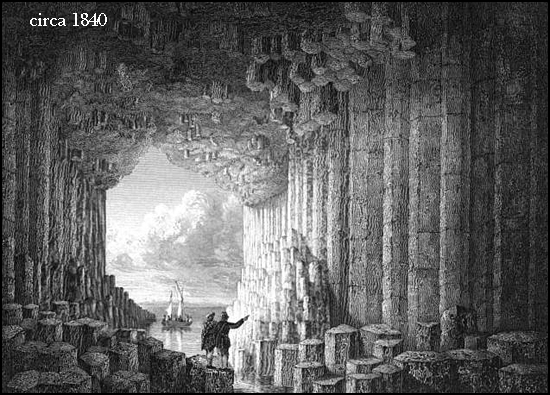
Sir Joseph Banks, 1st Baronet, (1743-1820) was a famous English naturalist, botanist and patron of the natural sciences. 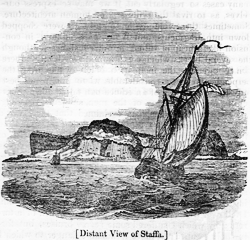 He was the first person to publicise Fingals Cave having visited Staffa in August 1772. His account was printed in the second edition of 'Pennant's Tour of Scotland'. Joseph Banks was on his way to Iceland when he diverted to Mull. Here he met up with a Mr Leach who guided the party to Staffa, explaining that the cave was one of the greatest wonders of the world. There is some debate as to whether the name Fingals Cave was derived from Bank's account based on a misunderstanding between the guide and himself. By 1832 Fingals Cave was a recognised tourist destination and a detailed account was published in the Penny Magazine of September 15th. To read this account click on the picture of Staffa right. He was the first person to publicise Fingals Cave having visited Staffa in August 1772. His account was printed in the second edition of 'Pennant's Tour of Scotland'. Joseph Banks was on his way to Iceland when he diverted to Mull. Here he met up with a Mr Leach who guided the party to Staffa, explaining that the cave was one of the greatest wonders of the world. There is some debate as to whether the name Fingals Cave was derived from Bank's account based on a misunderstanding between the guide and himself. By 1832 Fingals Cave was a recognised tourist destination and a detailed account was published in the Penny Magazine of September 15th. To read this account click on the picture of Staffa right.
Website: Click Here
ADDITIONAL INFORMATION
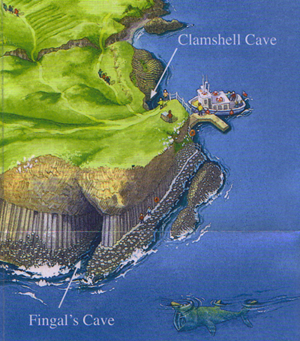
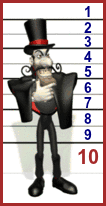

GREAT BRITISH GROTTO GRADING
Click to go to Grotto.Directory home page
CONSTRAINTS
Physical access difficult
FACILITIES
Access on Foot, Grotto with extensive rock gardens
LANDSCAPE
Coastal, Island, National Trust Property
REGION
Scotland
THE FEATURES PRESENT
+A created provenance that links it to ancient mythology or legend, +Cared for and maintained in good condition, +Dark and mysterious chambers and cave like spaces, +External rock structures, either real or simulated, +Fossils and/or shells incorporated into the decor, +Internal stonework that is natural, recycled or simulated to give a subterranean decor, +Stunning setting and location, GRADED SEVEN
|











 Isle of Staffa - Fingals Cave
Isle of Staffa - Fingals Cave